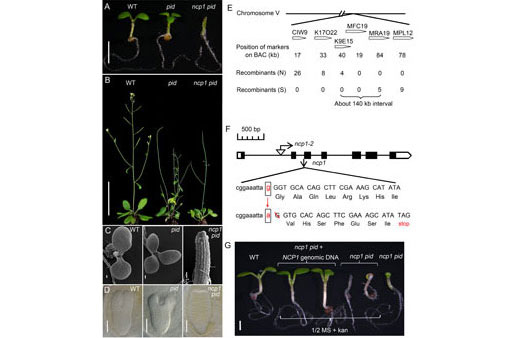PLOS Genetics:中科院程佑发研究组发现Hippo信号通路参与生长素介导
2016年3月4日,国际著名学术杂志《PLOS genetics》上在线发表中国科学院植物分子生理学重点实验室程佑发研究组的一篇研究论文,论文揭示了Hippo信号通路参与生长素介导的植物器官发生的调控机制。程佑发研究组的博士研究生崔晓娜与助理研究员郭志爱为该论文的共同第一作者,本文其它作者包括宋丽珍和王艳丽,程佑发研究员为论文通讯作者。
Hippo信号通路是近年来在动物中发现的一个信号通路,在调控动物细胞分裂、器官大小和肿瘤发生方面起重要作用。其关键成员的基因如果发生突变,会导致器官过度生长和肿瘤。该信号通路在动物中高度保守,但是植物是否也具有该通路及其作用机制还不清楚。中国科学院植物研究所程佑发研究组的最新研究结果表明,与动物中的Hippo信号通路的核心成员MOB1蛋白质高度相似的NCP1/AtMOB1A在生长素介导的植物生长发育过程中起重要作用。他们利用遗传学和生物化学的方法证明NCP1/AtMOB1A与生长素合成、极性运输和信号转导相关基因共同调控拟南芥的器官发生和胚胎发育。他们还发现果蝇的MOB1基因能够完全互补拟南芥atmob1a突变体的发育缺陷表型,说明动植物之间MOB1基因也具有功能保守性。这项研究揭示了植物MOB1在生长素调控的植物发育过程中的重要作用,为深入解析生长素的作用机理提供了一个新的切入点。

图1. ncp1突变体的鉴定与基因克隆。A-D, ncp1突变体增强生长素突变体pid的发育缺陷,双突变体的胚胎子叶缺失。E-G,图位克隆NCP1基因和互补实验。

图2. 果蝇MOB1基因(Mats)可以替换拟南芥NCP1/AtMOB1A基因起作用。A-B,用NCP1启动子驱动果蝇MOB1基因表达可以完全互补ncp1突变体的发育缺陷。C-D,突变体的角果长度和胚珠数目得到恢复。
原文链接:
NCP1/AtMOB1A Plays Key Roles in Auxin-Mediated ArABIdopsisDevelopment
原文摘要:
MOB1 protein is a core component of the Hippo signaling pathway in animals where it is involved in controlling tissue growth and tumor suppression. Plant MOB1 proteins display high sequence homology to animal MOB1 proteins, but little is known regarding their role in plant growth and development. Herein we report the critical roles of Arabidopsis MOB1 (AtMOB1A) in auxin-mediated development in Arabidopsis. We found that loss-of-function mutations inAtMOB1A completely eliminated the formation of cotyledons when combined with mutations inPINOID (PID), which encodes a Ser/Thr protein kinase that participates in auxin signaling and transport. We showed that atmob1a was fully rescued by its Drosophila counterpart, suggesting functional conservation. The atmob1a pid double mutants phenocopied several well-characterized mutant combinations that are defective in auxin biosynthesis or transport. Moreover, we demonstrated that atmob1a greatly enhanced several other known auxin mutants, suggesting that AtMOB1A plays a key role in auxin-mediated plant development. Theatmob1a single mutant displayed defects in early embryogenesis and had shorter root and smaller flowers than wild type plants. AtMOB1A is uniformly expressed in embryos and suspensor cells during embryogenesis, consistent with its role in embryo development. AtMOB1A protein is localized to nucleus, cytoplasm, and associated to plasma membrane, suggesting that it plays roles in these subcellular localizations. Furthermore, we showed that disruption of AtMOB1A led to a reduced sensitivity to exogenous auxin. Our results demonstrated that AtMOB1A plays an important role in Arabidopsis development by promoting auxin signaling.
DOI: 10.1371/journal.pgen.1005923
作者:程佑发

